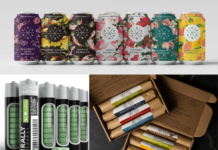There are many trends affecting consumers’ interaction with and purchasing behavior with food.
•Local and Organic: Organic producers need to do a better job explaining why their products cost more and why they are better. Younger people have a broader definition of local and older people support local food because of the local economy.
•Free-From: Many people are demanding things NOT be in their food (gluten-free, dairy-free etc.) and they want to understand the ingredients in their food, usually meaning a simpler list of ingredients.
•Snacks: Snacks are a big deal right now because younger generations are more likely to be grazers than older people (eating a little bit 6 times a day than to sit down for a big meal). People want their snack foods to be a meal replacement, give them energy, rather than being purely an “indulgence.”
Packaging is the place to communicate the story of your product, because this is how people are learning about your products. In-store signage (which you might not have control over) also affects how people learn about your product. Awareness of your product is great, but in food, people need to buy your product and then become repeat customers for your business to be financially sustainable. The cost of getting the consumer to try and buy your product is increasing greatly:
- Slotting Fees
- Free-fills
- Charge-backs
- Penalties for Out of Stocks
- Mandatory Promotions
- Chef Samples
- Product Formulation
- Brand Positioning
- Labels
The consumer is overwhelmed with choice and retailers are trying to satisfy the above trends to give them more choices given all of these niche diets and preferences. It is impossible to compete or stand out in the mind of the consumer without being defensibly unique in the business model and product of companies wishing to enter this marketplace.
What can make you defensibly unique?
- Product
- Ingredients
- Varietals
- Terroir
- Brand
- Packaging
- Availability
- Personal Relationships
- Customer Experience
Businesses go through life cycles, and we have recently experienced a flood in the market in terms of niche brands trying to fulfill the needs of the consumers in these trends. There is likely a shakeout coming, and being defensibly unique is the best way to both enter the marketplace and survive that shakeout.
Food Technology
There have been many new entrants into the food technology space, including meal kit delivery services and new ways to order food. While these companies have been able to raise lots of investor money, they often fail because they can’t find a sustainable business model.
There is a lot of interest in using technology to “disrupt” food. However, we do have a hard-wired relationship with food and like to forage for it, and those instincts are difficult if not impossible to change. While there is a place for technology to enhance customers’ relationships with food, true “disruption” of the fundamental dynamics of that relationship is likely a difficult goal to realize. A few things to consider about food technology:
- We don’t want other people shopping for us, or cooking for us, even though we’re busy, and we can’t explain why
- Cognitive neuroscience research shows that we were hard-wired to do these things in order for our species to survive
- Food Tech companies that succeed are likely to be the ones that use this to their advantage rather than trying to fight it



